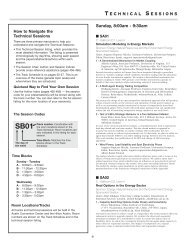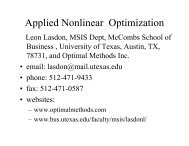Sunday
Sunday
Sunday
Create successful ePaper yourself
Turn your PDF publications into a flip-book with our unique Google optimized e-Paper software.
SB73<br />
■ SB73<br />
73- Suite 324- Hyatt<br />
Market Microstructure and High-Frequency Trading<br />
Cluster: Quantitative Finance<br />
Invited Session<br />
Chair: Gerry Tsoukalas, University of Pennsylvania,<br />
The Wharton School, Philadelphia, PA, United States of America,<br />
gtsouk@wharton.upenn.edu<br />
1 - General State Space Models in Electronic Market Making<br />
Vibhav Bukkapatanam, PhD Candidate, Stanford University,<br />
141O Huang Engineering Center, Stanford, CA, 94305,<br />
United States of America, vibhav@stanford.edu<br />
In recent years, the dramatic growth in electronic trading has revolutionized<br />
financial markets and led to the proliferation of high frequency market makers. In<br />
this work, we analyze how general state space models can be used in several key<br />
components of a maket making system, including spot variance and correlation<br />
estimation, regime switching modeling of high frequency data and optimal<br />
inventory control based bid-ask spreads estimation.<br />
2 - Predicting the Impact of a Proposed Securities<br />
Exchange Regulation<br />
Waraporn Tongprasit, Stanford University, Stanford, CA, United<br />
States of America, Waraporn@stanford.edu, Benjamin Van Roy<br />
We propose an approach to counterfactual analysis of securities exchanges that<br />
can be applied to predict the impact of proposed regulatory changes. We conduct<br />
an empirical case study in which we predict the impact of a historical tick size<br />
change on exchange efficiency and compare predictions to what can be inferred<br />
from subsequent data.<br />
3 - Disentangling Price Impact from Alpha<br />
Mehmet Saglam, Columbia University, New York, NY,<br />
United States of America, MSaglam13@gsb.columbia.edu,<br />
Ciamac Moallemi, Michael Sotiropoulos<br />
Motivated by the performance measurement literature in active portfolio<br />
management, we are interested in attributing the price changes observed during<br />
an execution of a large trade between the client’s short term predictive ability,<br />
alpha view, and the broker’s price impact. Using execution data with a large<br />
universe of clients, we show that incorporating client’s alpha view drastically<br />
increases the explanatory power of existing models and enables to accurately<br />
estimate the price impact.<br />
4 - Optimal Trade Execution using Limit Order Book Information<br />
Rolf Waeber, Cornell University, 206 Rhodes Hall, Ithaca, NY,<br />
14853, United States of America, rw339@cornell.edu,<br />
Sasha Stoikov<br />
We consider an asset liquidation problem at the market microstructure level,<br />
given observations of the limit order book. The optimization is formulated in<br />
terms of a sequence of stopping times, at which we submit market sell orders. We<br />
describe the shape of the trade and no trade regions for different price and latency<br />
assumptions. In the empirical section, we show that our policy signicantly<br />
outperforms a benchmark TWAP algorithm on US treasury bonds.<br />
<strong>Sunday</strong>, 1:30pm - 3:00pm<br />
■ SC01<br />
01- West 101- CC<br />
Optimization in Data Mining<br />
Sponsor: Optimization/Global Optimization<br />
Sponsored Session<br />
Chair: Onur Seref, Assistant Professor, Virginia Tech, 1007 Pamplin<br />
Hall, Blacksburg, VA, 24061, United States of America, seref@vt.edu<br />
1 - How to Reverse-Engineer Quality Rankings<br />
Cynthia Rudin, Assistant Professor, Massachusetts Institute of<br />
Technology, 77 Massachusetts Avenue, Cambridge, MA,<br />
United States of America, rudin@mit.edu, Michael Cavaretta,<br />
Gloria Chou, Robert Thomas, Allison Chang<br />
A good or bad product quality rating can make or break an organization.<br />
However, the notion of “quality” is often defined by an independent rating<br />
company that does not make the formula for ranking products public. We provide<br />
a machine learning approach for “reverse-engineering” a rating company’s<br />
proprietary model as closely as possible.<br />
INFORMS Phoenix – 2012<br />
104<br />
2 - A Probabilistic Model for Assessing the Mortality Risk in<br />
Post-operative Patients<br />
Dmytro Korenkevych, 372 Maguire Village, Apt. 1, Gainesville, FL,<br />
32603, United States of America, dmitriy@ufl.edu, Petar<br />
Momcilovic, Panos Pardalos<br />
We used a probabilistic model based on Bayesian learning and optimization<br />
techniques to estimate the mortality risk in post-operative patients. The model<br />
incorporates discrete and continuous risk factors and provides a probabilistic score<br />
associated with the risk. The feature selection procedure was applied in order to<br />
discard irrelevant risk factors and 70/30 cross-validation analysis was performed<br />
to estimate the accuracy of the model.<br />
3 - Information-Theoretic Learning for Stimulus-specific<br />
Clustering with fMRI<br />
Chun-An (Joe) Chou, University of Washington, 3900 Stevens<br />
Way, Seattle, WA, United States of America, joechou@uw.edu,<br />
Kittipat “Bot” Kampa, Art Chaovalitwongse<br />
Multi-Voxel Pattern Analysis (MVPA) is a popular approach for cognitive<br />
recognition with functional MRI (fMRI), as it is consistent with a neural system<br />
that mental operations/representations are instantiated in a neural population<br />
code spanning multiple voxels. In this work, we employ an unsupervised<br />
clustering with an information-theoretic measure to identify the spatial patterns<br />
of voxels in response to stimuli. The results illustrate that there are specific<br />
clusters for different stimuli.<br />
4 - Optimization Models for Predicting the Antigenic Variants of<br />
Influenza A/H3N2 Virus<br />
Serdar Karademir, University of Pittsburgh, 1048 Benedum Hall,<br />
Pittsburgh, United States of America, sek73@pitt.edu<br />
We use the pairwise amino acid sequence comparison of influenza strains and the<br />
antigenic distance between each pair as input for a classification model to identify<br />
immunodominant positions that cause antigenic variety. The performance of the<br />
model is evaluated through cross validation where cross validation is modeled as<br />
an optimization program that minimizes the misclassification error. Comparison<br />
to results of existing classification methods in literature is also provided.<br />
■ SC02<br />
02- West 102 A- CC<br />
DA Entrepreneurs Speak: Challenges and<br />
Opportunities in Building Decision Analysis<br />
Based Businesses<br />
Sponsor: Decision Analysis<br />
Sponsored Session<br />
Chair: Chris Dalton, CEO, Syncopation Software, 6 State Street,<br />
Suite 402, Bangor, ME, 04401, United States of America,<br />
cdalton@syncopation.com<br />
1 - Tales from the Decision Analysis Industrial Complex<br />
Chris Dalton, CEO, Syncopation Software, 6 State Street,<br />
Suite 402, Bangor, ME, 04401, United States of America,<br />
cdalton@syncopation.com<br />
This talk will define what it means to be a Decision Analysis based business, and<br />
give examples of successful and unsuccessful DA business models. At the end of<br />
the session, we will have a panel discussion with the speakers and other members<br />
of the DA business community.<br />
2 - Building Decision Analysis Based Businesses<br />
Carl Spetzler, CEO, Strategic Decisions Group, 745 Emerson Street,<br />
Palo Alto, CA, 94301, United States of America, cspetzler@sdg.com<br />
As an early member of the original Decision Analysis Group at SRI Internaional<br />
and then one of the founders of SDG, I have participated in and observed about a<br />
dozen of start-up companies based on the power of DA. In this session, I will<br />
share my observations from the successes and failures of these entrepreneurial<br />
efforts.<br />
3 - Business Analytics, Information Technology, and Decision<br />
Analysis<br />
Don Kleinmuntz, Exec VP & Cofounder, Strata Decision<br />
Technology, 200 E Randolph St 49th Floor, Chicago, IL, 60601,<br />
United States of America, dnk@strata-decision.com<br />
Business Analytics is a huge wave that has overtaken a number of industries and<br />
is guiding the development of IT infrastructure in many others. There is a genuine<br />
opportunity to embed decision analysis tools and processes in that infrastructure<br />
and create tremendous impact.



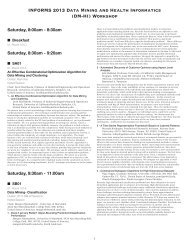
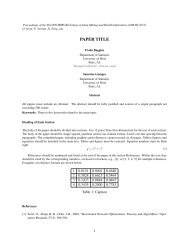
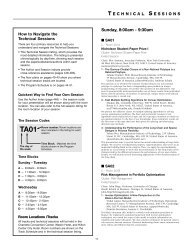
![[PDF] Charlotte Back Matter](https://img.yumpu.com/17933057/1/190x245/pdf-charlotte-back-matter.jpg?quality=85)

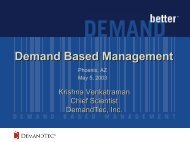
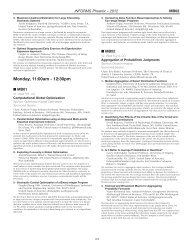
![[PDF] ALIO Back Matter](https://img.yumpu.com/17932960/1/190x245/pdf-alio-back-matter.jpg?quality=85)

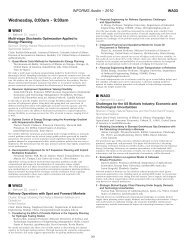
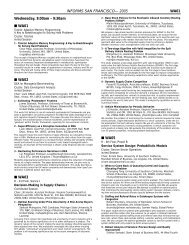
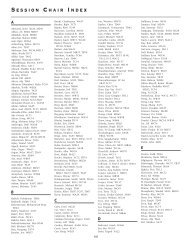
![[PDF] Monday, 8:00am - 9:30am](https://img.yumpu.com/17932954/1/190x245/pdf-monday-800am-930am.jpg?quality=85)
